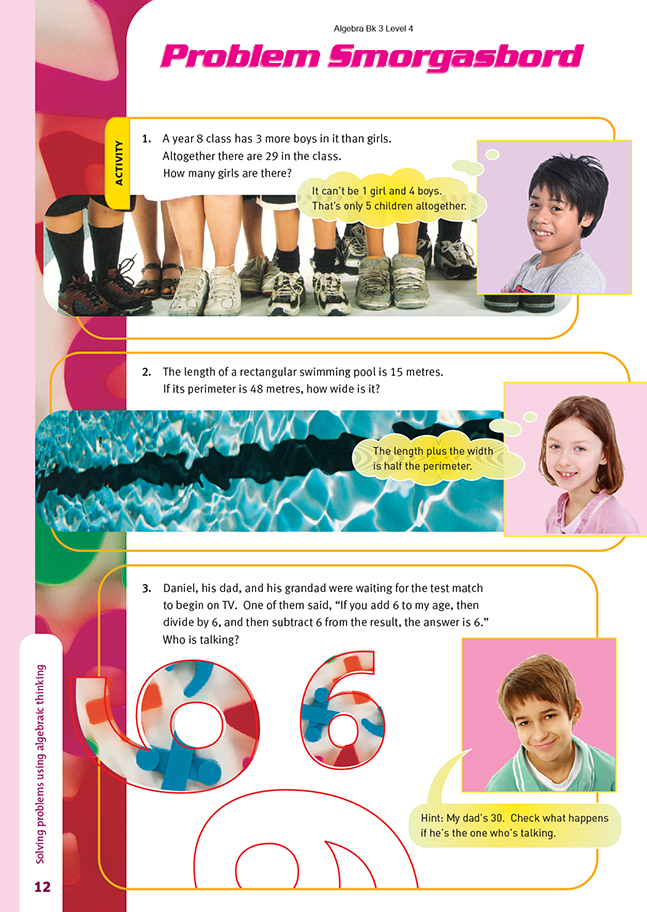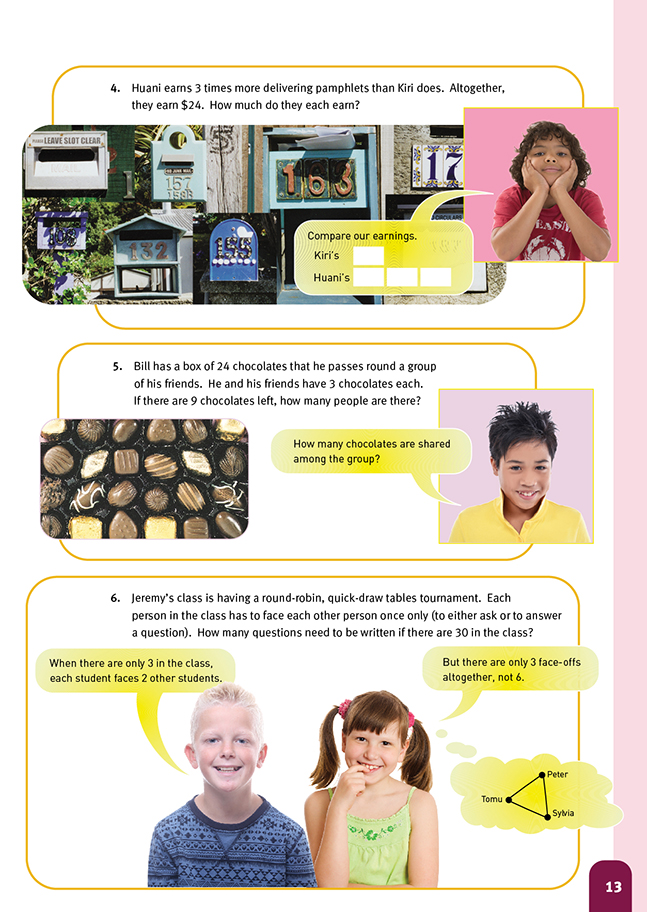This is a level 4 algebra strand activity from the Figure It Out series.
A PDF of the student activity is included.
Click on the image to enlarge it. Click again to close. Download PDF (515 KB)
use a linear equation to solve a problem
FIO, Level 4, Algebra, Book Three, Problem Smorgasboard, pages 12-13
In this activity, students must use a variety of problem-solving strategies.
In question 1, the students might use a trial-and-improvement strategy to work out that there are 13 girls and 16 boys. (10 girls would mean 19 boys, 12 girls would mean 17 boys, and so on.)
An alternative approach is to visualise the problem like this:
.gif)
The diagram or model shows that the number of boys equals the number of girls plus 3. This means that twice the number of girls would give 26 children. So there are 13 girls. This model is only a small step away from using algebra for equations.
.gif)
When there are x girls, there are x + 3 boys. So we can write an equation for the problem: x + (x + 3) = 29. If 2x + 3 = 29, 2x = 26, so x = 13. This means that there are 13 girls and therefore 16 boys.
In question 2, students will find it helpful to draw a diagram of the rectangular pool and then label the lengths. The perimeter (the distance around the edge), of the pool is 48 metres. So, width + width + 15 m + 15 m = 48 m. This means that 2 x width = 18 metres, so the width is 9 metres. Once again, some students could use an algebraic approach. In this case, an equation for the problem is 48 = 2 x 15 + 2 x x (where x is the width) or 48 = 30 + 2x. This means that 18 = 2x (subtracting 30 from both sides) and that x = 9 (dividing both sides by 2).
In question 3, if the students check the outcome when a 30-year-old is talking, this is what happens:
Starting age 30
Add 6 36
Divide by 6 6
Subtract 6 0
The outcome here is 0, so it is likely that the person who is talking is considerably older than 30, that is, Grandad. The students might use a trial-and-improvement strategy to work out the age of the person talking and confirm that it is Grandad. They might also try a working backwards strategy. This involves reversing
the procedure, starting with 6, then following the sequence of instructions: add 6, multiply by 6, subtract 6.
This backtracking diagram or flow chart shows what happens.
.gif)
So the age of the person talking is 72 – 6 = 66, and the person is Grandad.
In question 4, students might try the visual approach suggested by Huani.
.gif)
This can lead to an algebraic approach involving equations: If Kiri earns x, Huani earns 3x. Together, x + 3x = 24 or 4x = 24, giving x = 6. So Kiri earns $6, and Huani earns $18.
A visual model can also be used for question 5:
.gif)
Each person gets 3 of the chocolates that were shared, so there were 5 people altogether (David and 4 of his friends) who each had 3 chocolates.
In question 6, the students should explore how many face-offs there are with just 2, then 3, then 4 students, and so on. They might record their results in a table and see if they can work out a rule that will help them predict the number of face-offs for 30 students.
Their exploratory work might involve diagrams like these. Each line represents a face-off or question, so 3 lines mean that 3 questions are needed.
.gif)
Some students may quickly reason that when, for example, there are 5 students, each student faces off with the other 4 students, making a total of 20 face-offs. But a face-off from A to B is the same as a face-off from B to A, so there are in fact one-half of 20 or 10 face-offs. They might then reason that with 30 students, each student faces off with the other 29 students, giving what appears to be 30 x 29 = 870 face-offs. But as indicated earlier, a face-off from A to B is the same as a face-off from B to A. So, altogether, there are 870 ÷ 2 = 435 face-offs or questions needed for 30 students.
It is unlikely that many students will accomplish the reasoning above. An alternative strategy is to make a table of their results from their initial exploratory work.
.gif)
This rule can also be expressed algebraically. For x students, y questions are needed. The pattern in the table above suggests that ![]()
However, while this rule may seem obvious once you have seen the pattern for the number of questions needed, it can nevertheless be challenging for many students.
The students may also notice a pattern in the table above with regard to the way the number of questions increases. For example, if there are 4 students, we need 6 questions, but if we add another student, we will need 4 more (that is, 10) questions. This makes sense because the fifth student will need to face off with each of the other 4 students, which gives a total of 4 + 6 = 10 questions. So the number of questions needed can be found as the sum of the two numbers in the row above.
The following table provides another way to record face-offs for a quick-draw tables tournament. Here, there are 8 students involved in face-offs. Students must find a short cut way to count face-offs A v B, A v C, and so on.
.gif)
For these 8 students, there are 8 rows of 8 squares in the table to be filled in. But each row has a shaded space, representing A v A, B v B, and so on, which makes no sense. So, there are actually 8 rows of 7 spaces to be filled. But half of these are duplicated (see the empty spaces above the shaded spaces), so in fact, there are really just 1/2 of 8 rows of 7 spaces to be filled. This is 1/2 of 8 x 7, which is 56 ÷ 2 = 28 spaces, which is the formula we found before. Each of these spaces represents a face-off or question, so when there are 8 students, 28 questions are needed. Similarly, when there are 10 students, there are 1/2 of 10 x 9 or 90 ÷ 2 = 45 questions needed. And when there are 30 students, 1/2 of 30 x 29 = 435 questions are needed.
Note that the mathematics in this question is identical to the mathematics in the Web Circles activity on page 18.
Answers to Activity
1. 13. (There are 16 boys.)
2. 9 m
3. Grandad. (He is 66 years old.)
4. Huani earns $18, and Kiri earns $6.
5. 5
6. 435

